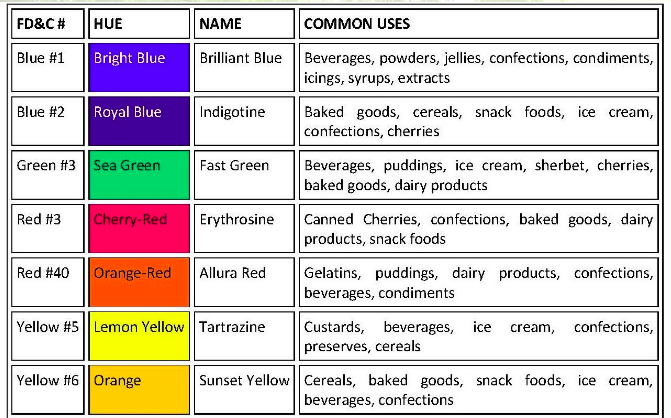Artificial Food Dyes.
What Does Your Gut Tell You?
Do foods with bright colours have your child grabbing and throwing them in your grocery cart? Do you desperately fish them out and put them back on the shelf? Or do you generally feel fine with them?
Would you be shocked to learn that more than half a million children in North America are estimated to suffer adverse behavioural reactions after ingesting food dyes? Yet a majority of child-oriented food products sold are artificially coloured.
Food manufacturers do this on purpose. They know foods that are vivid in colour are much more attractive and appetizing to kids and will have them asking…and begging for parents to buy them. For example:
A single cup of Kool-Aid Burst Cherry contains 50 mg of dyes—or nearly twice the amount (26 mg or less) demonstrated in studies to trigger behavioural reactions in some children;
A 16 ounce bottle of Sunny D Orange Strawberry contains nearly 40 mg of dyes;
A mere two tablespoons of Pillsbury Confetti Funfetti Chocolate Fudge Frosting contains a shocking 41.5 mg of dyes
A single cup of Hawaiian Punch (14.1 mg) plus 4 pieces of Twizzlers (15.4 mg) or a Red, White and Blue Popsicle (21.6 mg) would bring a child over 26 mg
Are Artificial Food Dyes Safe for Kids?
This is the million dollar question that we will look at. Studies have linked food dyes to:
Hyperactivity, including ADHD
Behavioural changes like irritability and depression
Hives and asthma.
Regulations
Regulations in North America state that there is not enough scientific evidence to say artificial food dyes cause negative effects on children’s health. Food dyes are even permitted in everyday foods from bread, butter, milk and cheese and also medications and supplements.
Not everyone agrees that food dyes are harmful. Interestingly, some food dyes are deemed safe in one country, but banned from human consumption in another, making it extremely confusing to assess their safety.
What to look for?
Whatever your gut tells you, it is never a bad idea to read food labels and know what you and your family are consuming. These are names of dyes you might look for on the label when choosing a packaged food. Companies are required by law to list the name of the dye on the ingredient list...and that can still be tricky as there are different names you may not know.
Red No. 3 (Erythrosine): A cherry-red colouring commonly used in candy, popsicles and cake-decorating gels
Red No. 40 (Allura Red): A dark red dye that is used in sports drinks, candy, condiments and cereals
Yellow No. 5 (Tartrazine): A lemon-yellow dye that is found in candy, soft drinks, chips, popcorn and cereals
Yellow No. 6 (Sunset Yellow): An orange-yellow dye that is used in candy, sauces, baked goods and preserved fruits
Blue No. 1 (Brilliant Blue FCF): A greenish-blue dye used in ice cream, canned peas, packaged soups, popsicles and icings
Blue No. 2 (Indigo Carmine): A royal blue dye found in candy, ice cream, cereal and snacks
Here are some other ways they can be named:
Citrus Red No.2
Fast green FCF
Indigotine
Amaranth Red
Ponceau SX
WHAT CAN YOU DO? Healthy Whole Foods Are Naturally Free of Dyes
The best way to remove artificial food dyes from your diet is to focus on eating whole, unprocessed foods. Unlike processed foods, most whole foods are highly nutritious.
Here are a few foods that are naturally dye-free (but still check the labels as brands are different):
Dairy and eggs: Milk, plain yogurt, cheese, eggs, cottage cheese.
Meat and poultry: Fresh chicken, beef, pork and fish (not marinated)
Nuts and seeds: Unflavoured almonds, macadamia nuts, cashews, pecans, walnuts, sunflower seeds.
Fresh fruits and vegetables: All fresh fruits and vegetables.
Grains: Oats, brown rice, quinoa, barley.
Legumes: Black beans, kidney beans, chickpeas, navy beans, lentils.
You can also get inventive at home and add colour to your own cooking without food dyes. This can be done by boiling, blending, and/or pureeing vegetables or fruits for their natural colours.
Try these:
Raspberries, pomegranate and beets - pink/purple
Carrots – orange
Turmeric powder – yellow
Blueberry – blue
Spinach – green
Red cabbage – purple and blue
For purple, boil cabbage in hot water until water is dark purple colour
For blue, slowly add some baking soda to purple water
Nourished Beginnings Dietitian’s Bottom Line
NOURISHED BEGINNINGS BOTTOM LINE
While there is no conclusive evidence that food dyes are dangerous for most people we nevertheless know the evidence is growing and research is strong in some areas. They may cause allergic reactions in some people and hyperactivity in sensitive children.
We are generally suspicious of foods that are highly processed. We encourage eating foods as close to how they are grown as possible. Food dyes are pretty far away from home grown. We also know that life is life and children are going to be exposed to these artificially coloured foods. We want them to enjoy life, events and the pleasures around them.
The reality is that most food dyes are found in unhealthy processed foods that should be limited anyhow. So, instead, we recommend focusing on eating nutritious whole foods that are naturally dye-free.
If your child has behaviour concerns, such as ADD/ ADHD we definitely encourage doing a food dye challenge. Avoid all foods with artificial food dyes for a period of time and see if their behaviour changes. Add some back in if needed and watch for further alterations in behaviour. You’ll have your answer pretty quickly.





